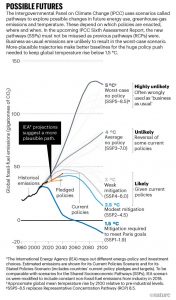How Hot Will Things Get?
Identifying a realistic worst case scenario is complicated.
How hot will the world be in 2100? The answer partly depends on how much carbon we dump in the atmosphere between now and then. It also depends on how sensitive the climate system is to those emissions. Scientists have used 4.5 °C as the high end of the likely possibilities.
That estimate derives from a climate scenario called RCP8.5. (RCP stands for Representation Concentration Pathway.) That scenario assumes little or no effort to control carbon emissions. It’s customarily called the “business as usual” scenario. This map from their article, which may or may not show up in the emailed version of this post, shows the various scenarios:
In a January 2020 essay in the journal Nature, two climate scientists argued that RCP8.5 shouldn’t be considered business as usual any more. They argued that it is in fact unlikely that we will burn anyway near as much coal as this scenario assumes. In reality, they said, coal use seems to be peaking, and renewable energy gets cheaper all the time. They worry that people fixate on this high emissions scenario and assume that the gulf between that and our climate goals is too big to be crossed.
Even a 3° temperature increase would still have extremely serious consequences, but it wouldn’t be as catastrophic as 5°.
This essay was controversial. Some critics worried that it would undermine messaging about the urgency of the climate issue or give ammunition to climate denialists. Others argued that the 5° scenario was still a realistic possibility, even if it was not as likely as previously believed.

The curve at the top is the RCP8.5 scenario. The light blue and gray ones further down are the ones they view as likely.
At the same time that scientists were debating how much future emissions to assume, new model results began to show that climate is more sensitive to emissions than previously thought. Because the models are enormously complex, it’s not easy to tease out what’s driving the new results. But according to a recent analysis of the modeling results, the reason for the change seems to be better models of cloud formation. Predicting climate change involves taking into account many feedback effects. Some tend to limit warming. In particular, low-level clouds reflect sunlight during the day, cooling the planet. Previous models predicted that warming would increase cloudiness, putting the brakes on further warming. The new models indicate that this braking effect will be weaker. (The differences between models seem to relate to the proportion of ice crystals in clouds versus water droplets.) The result is that for any given concentration of greenhouse gases, there will be a bit more warming. This could push the 3° scenario up to a 4° warming.
Whether we consider the worst realistic scenario to be 5° or 4°, the consequences will still be extremely bad. And we’re still very far from the degree of emissions reductions we need to avoid those consequences. While the scientists are debating the models, we need to roll up our sleeves and get to work on decarbonizing the economy.







Reader Comments